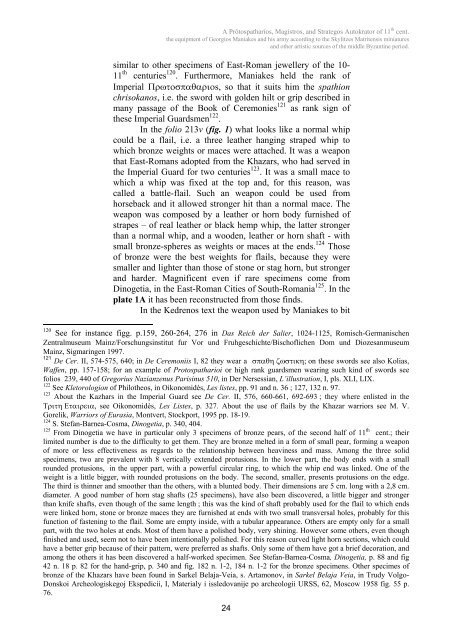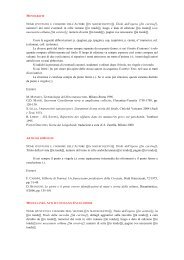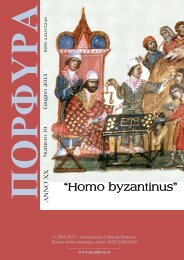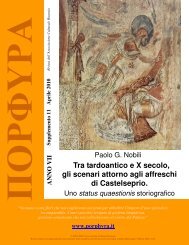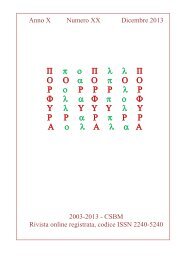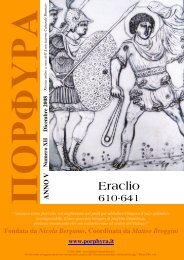ΠΟΡΦΥΡΑ - Porphyra
ΠΟΡΦΥΡΑ - Porphyra
ΠΟΡΦΥΡΑ - Porphyra
Create successful ePaper yourself
Turn your PDF publications into a flip-book with our unique Google optimized e-Paper software.
A Prôtospatharios, Magistros, and Strategos Autokrator of 11 th cent.<br />
the equipment of Georgios Maniakes and his army according to the Skylitzes Matritensis miniatures<br />
and other artistic sources of the middle Byzantine period.<br />
similar to other specimens of East-Roman jewellery of the 10-<br />
11 th centuries 120 . Furthermore, Maniakes held the rank of<br />
Imperial Πρωτοσπαθαριοs, so that it suits him the spathion<br />
chrisokanos, i.e. the sword with golden hilt or grip described in<br />
many passage of the Book of Ceremonies 121 as rank sign of<br />
these Imperial Guardsmen 122 .<br />
In the folio 213v (fig. 1) what looks like a normal whip<br />
could be a flail, i.e. a three leather hanging straped whip to<br />
which bronze weights or maces were attached. It was a weapon<br />
that East-Romans adopted from the Khazars, who had served in<br />
the Imperial Guard for two centuries 123 . It was a small mace to<br />
which a whip was fixed at the top and, for this reason, was<br />
called a battle-flail. Such an weapon could be used from<br />
horseback and it allowed stronger hit than a normal mace. The<br />
weapon was composed by a leather or horn body furnished of<br />
strapes – of real leather or black hemp whip, the latter stronger<br />
than a normal whip, and a wooden, leather or horn shaft - with<br />
small bronze-spheres as weights or maces at the ends. 124 Those<br />
of bronze were the best weights for flails, because they were<br />
smaller and lighter than those of stone or stag horn, but stronger<br />
and harder. Magnificent even if rare specimens come from<br />
Dinogetia, in the East-Roman Cities of South-Romania 125 . In the<br />
plate 1A it has been reconstructed from those finds.<br />
In the Kedrenos text the weapon used by Maniakes to bit<br />
120 See for instance figg. p.159, 260-264, 276 in Das Reich der Salier, 1024-1125, Romisch-Germanischen<br />
Zentralmuseum Mainz/Forschungsinstitut fur Vor und Fruhgeschichte/Bischoflichen Dom und Diozesanmuseum<br />
Mainz, Sigmaringen 1997.<br />
121 De Cer. II, 574-575, 640; in De Ceremoniis I, 82 they wear a σπαθη ζωστικη; on these swords see also Kolias,<br />
Waffen, pp. 157-158; for an example of Protospatharioi or high rank guardsmen wearing such kind of swords see<br />
folios 239, 440 of Gregorius Nazianzenus Parisinus 510, in Der Nersessian, L’illustration, I, pls. XLI, LIX.<br />
122 See Kletorologion of Philotheos, in Oikonomidès, Les listes, pp. 91 and n. 36 ; 127, 132 n. 97.<br />
123 About the Kazhars in the Imperial Guard see De Cer. II, 576, 660-661, 692-693 ; they where enlisted in the<br />
Τριτη Εταιρεια, see Oikonomidès, Les Listes, p. 327. About the use of flails by the Khazar warriors see M. V.<br />
Gorelik, Warriors of Eurasia, Montvert, Stockport, 1995 pp. 18-19.<br />
124 S. Stefan-Barnea-Cosma, Dinogetia, p. 340, 404.<br />
125 From Dinogetia we have in particular only 3 specimens of bronze pears, of the second half of 11 th cent.; their<br />
limited number is due to the difficulty to get them. They are bronze melted in a form of small pear, forming a weapon<br />
of more or less effectiveness as regards to the relationship between heaviness and mass. Among the three solid<br />
specimens, two are prevalent with 8 vertically extended protusions. In the lower part, the body ends with a small<br />
rounded protusions, in the upper part, with a powerful circular ring, to which the whip end was linked. One of the<br />
weight is a little bigger, with rounded protusions on the body. The second, smaller, presents protusions on the edge.<br />
The third is thinner and smoother than the others, with a blunted body. Their dimensions are 5 cm. long with a 2,8 cm.<br />
diameter. A good number of horn stag shafts (25 specimens), have also been discovered, a little bigger and stronger<br />
than knife shafts, even though of the same length ; this was the kind of shaft probably used for the flail to which ends<br />
were linked horn, stone or bronze maces they are furnished at ends with two small transversal holes, probably for this<br />
function of fastening to the flail. Some are empty inside, with a tubular appearance. Others are empty only for a small<br />
part, with the two holes at ends. Most of them have a polished body, very shining. However some others, even though<br />
finished and used, seem not to have been intentionally polished. For this reason curved light horn sections, which could<br />
have a better grip because of their pattern, were preferred as shafts. Only some of them have got a brief decoration, and<br />
among the others it has been discovered a half-worked specimen. See Stefan-Barnea-Cosma, Dinogetia, p. 88 and fig<br />
42 n. 18 p. 82 for the hand-grip, p. 340 and fig. 182 n. 1-2, 184 n. 1-2 for the bronze specimens. Other specimes of<br />
bronze of the Khazars have been found in Sarkel Belaja-Veia, s. Artamonov, in Sarkel Belaja Veia, in Trudy Volgo-<br />
Donskoi Archeologiskegoj Ekspedicii, I, Materialy i issledovanije po archeologii URSS, 62, Moscow 1958 fig. 55 p.<br />
76.<br />
24


